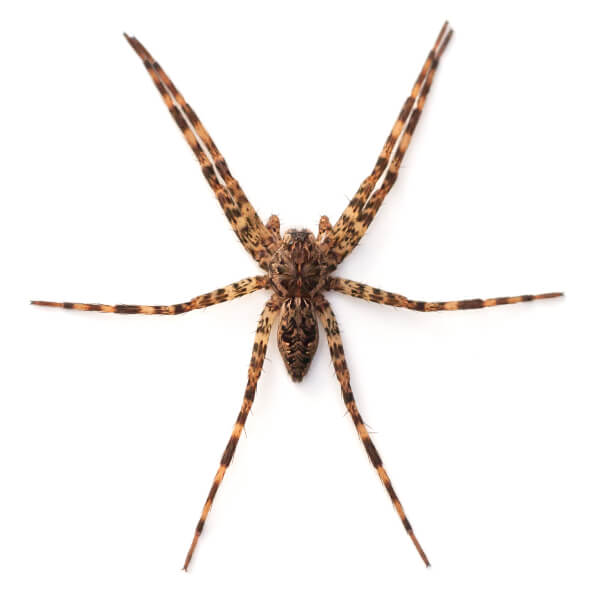Fishing spiders
 | |
| Domain: | Eukaryota |
|---|---|
| Kingdom: | Animalia |
| Phylum: | Arthropoda |
| Subphylum: | Chelicerata |
| Class: | Arachnida |
| Order: | Araneae |
| Family: | Pisauridae |
| Genus: | Dolomedes |
Overview
Dolomedes is a genus within the spider family Pisauridae, meaning that while all Dolomedes species are part of the Pisauridae family, not all Pisauridae belong to the genus Dolomedes. The Pisauridae family, commonly referred to as nursery web and fishing spiders, includes several genera characterized by their active hunting behavior and, in some cases, associations with aquatic habitats. Dolomedes is one of the most prominent and widely recognized genera in this family, known for its semi-aquatic lifestyle and ability to walk on water and dive beneath the surface to catch prey. Other genera in the Pisauridae family, such as Pisaura, exhibit different behaviors, like building nursery webs to protect their egg sacs, but share similar morphological traits. Therefore, Dolomedes represents a specific and specialized group within the broader, more diverse Pisauridae family. There are approximately 100 species of Dolomedes across the world, with 9 species existing in North America.
Description
Dolomedes spiders, commonly known as fishing spiders, are among the largest true spiders in North America and Europe. They typically have a body length ranging from 10 to 25 millimeters, with leg spans that can exceed 75 millimeters. Their bodies are robust and elongated, often colored in shades of brown, gray, or black, with lighter markings along the cephalothorax and abdomen that help with camouflage in natural settings. One of their distinguishing features is their long, powerful legs, which are covered in hydrophobic hairs that allow them to move across the surface of water. Like other members of the Pisauridae family, Dolomedes spiders have eight eyes arranged in two horizontal rows, giving them excellent vision for detecting movement in their environment.
Behavioral Habits
Dolomedes spiders are active hunters that do not rely on webs to catch their prey. Instead, they use their keen eyesight and sensitivity to vibrations to detect and ambush insects, small fish, tadpoles, and other aquatic organisms. They can stand or run across water, and some species can even dive below the surface to pursue or escape. When diving, they can remain submerged for several minutes by trapping air around their bodies. Dolomedes spiders are generally solitary and nocturnal, doing most of their hunting at night. Females are also known for their parental care; they carry their egg sacs in their jaws and build protective nursery webs for their spiderlings, a trait shared with other Pisauridae.

Habitats
Dolomedes spiders are commonly found in habitats near freshwater, including the edges of ponds, lakes, marshes, and slow-moving streams. They prefer areas with dense vegetation and low human disturbance, which provide both cover and a steady supply of prey. Their distribution is widespread, with various species occurring in North America, Europe, Asia, and parts of Australia. The presence of water is crucial to their lifestyle, as it provides both a hunting ground and an escape route from predators. Some species have adapted to life in wet forests or flooded grasslands, highlighting their ecological versatility within aquatic or semi-aquatic environments. [1]
Mating and Reproduction
Reproduction litter size: 1000 - 1200. Dolomedes spiders exhibit notable reproductive behaviors, particularly in their courtship and maternal care. Mating typically occurs in the warmer months, during which males must approach females cautiously to avoid being mistaken for prey. Courtship often involves leg tapping or vibration signaling on the water or substrate to identify themselves as potential mates. After mating, the female produces a spherical egg sac, which she carries in her chelicerae for several days to weeks. During this time, she remains mobile and continues to hunt. When the spiderlings are close to hatching, the female constructs a nursery web—an enclosed silken structure, usually in nearby vegetation, where she suspends the egg sac. [3] She guards the nursery web vigilantly until the young emerge and disperse. This high level of maternal investment, including egg sac transport and web guarding, is characteristic of the Pisauridae family and helps improve offspring survival in the wild. [2]

Taxonomy
The taxonomy of Dolomedes places it within the family Pisauridae, which encompasses a group of spiders commonly known as fishing and nursery web spiders. The Pisauridae family falls under the order Araneae (spiders) and the class Arachnida, which includes all arachnids such as scorpions, mites, and ticks. Within the family Pisauridae, Dolomedes is one of the most notable genera, alongside others like Pisaura and Tinus. The genus Dolomedes contains several species, including the common Dolomedes tenebrosus (dark fishing spider) and Dolomedes fimbriatus (raft spider), which are primarily found in North America and Europe. The genus name Dolomedes was first coined by the French arachnologist Pierre André Latreille in 1804, derived from the Greek words "doloma" (deception) and "edes" (appearance), possibly alluding to the spider's ability to blend in with its surroundings. The species within Dolomedes are further classified based on their specific habitat preferences, behaviors, and physical characteristics [6]
References
[1] “Dark Fishing Spider.” Missouri Department of Conservation, 31 Dec. 2024, mdc.mo.gov/discover-nature/field-guide/dark-fishing-spider#:~:text=Habitat%20and%20Conservation,occurs%20in%20drier%20wooded%20areas. Accessed 7 Apr. 2025.
[2] Schwartz, Steven K., et al. “Spontaneous Male Death and Monogyny in the Dark Fishing Spider.” Biology Letters, vol. 9, no. 4, The Royal Society, Aug. 2013, p. 20130113, https://doi.org/10.1098/rsbl.2013.0113. Accessed 7 Apr. 2025.
[3] Foelix, Rainer F. Biology of Spiders. 3rd ed., Oxford University Press, 2011.
[4] Adam Tyrrell. “Can Spiders Walk on Water? - Rove Pest Control.” Rove Pest Control, 10 Dec. 2020, www.rovepestcontrol.com/blog/can-spiders-walk-on-water/.
[5] SERRAO, JOHN. “Okefenokee Fishing Spider with Egg Sac .” Science Photo Library, 2022, www.sciencephoto.com/media/1257563/view/okefenokee-fishing-spider-with-egg-sac.
[6] Bradley, Richard A. Common Spiders of North America. University of California Press, 2013.